

|
||||||||
Birding TipsThe following sections give detailed tips on birding at Magee:
Birding the BoardwalkThe boardwalk at Magee is just under a mile long, and there are different habitats along its length. As such, you'll find that particular spots along the boardwalk are better than others for seeing birds—and even for seeing specific species of birds. The map below shows the general layout of the boardwalk. We'll walk through the numbered sites in the text below. You can click on any number in the map to go directly to the descriptive text. (Note that the numbers in this map do not correspond with the numbers etched into the boardwalk's handrail).Click on numbered sites in map

Click on numbered sites in map
There are a small number of sites off the
boardwalk that can be
productive, when conditions are right. When the wind is blowing
from
the south, birds will often come to the edge of the forest bordering
the parking lots, and then it
may be better to view them from the various sites in and around the
West Lawn, than on the actual boardwalk. Conversely, when the
wind is
howling out of the north, the parking area will generally be devoid of
birds, and then you'll want to hit the back part of the boardwalk that
faces the marsh (to the south). Click on the numbered sites
below, or scroll down further to browse the complete list.1. West Platform The platform is the first thing you'll see when you approach the west entrance to the boardwalk. The platform itself isn't great for seeing birds (though sometimes you'll spot a few coming out of the woods there), and it's not very big, but there is a panel illustrating the field markings of the various warblers, which can be useful for beginners (see also the Field Guide page of this web site).  Plaque on the platform showing species
of warblers that can be seen at Magee Marsh.
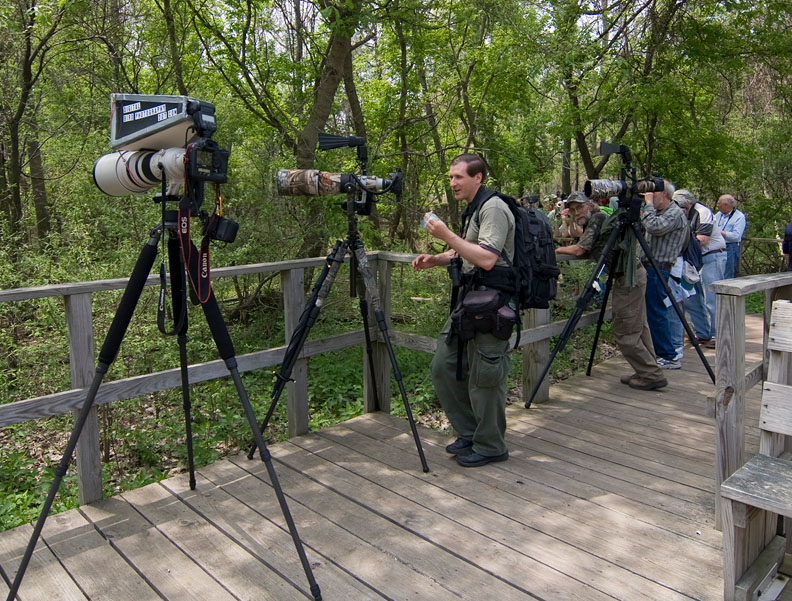 Another view of the platform, showing
the entrance to the boardwalk (at right). Large tripod-mounted camera rigs are not recommended on the boardwalk,
but on the platform and atop the west tower there's more room.
2. Corner near PlatformThis corner is sometimes productive, as the birds will occasionally come out here and along the other edges of the West Lawn. There's a rather large tree that grows in the lawn near this corner, where birds will sometimes forage, so when you're birding this corner it's a good idea to keep an eye on the tree behind you. Note that people often place oranges (and occasionally more exotic fruits such as bananas, canteloupes, and even pineapples) in the trees here, so this tends to be a good place to see orioles. 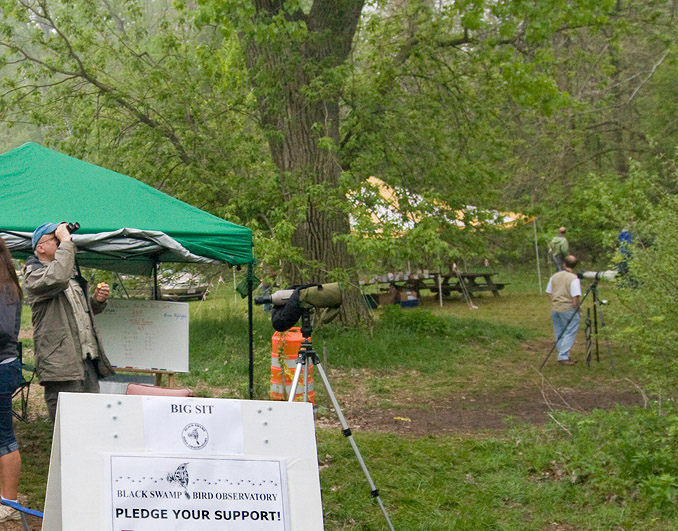 Corner of west lawn, near the
platform. When conditions are right, birds sometimes come out to the forest edge and can be seen from the lawn. This
corner is sometimes good. The annual Big Sit on International Migratory Bird Day
takes place here. Some birds come all the way out to the big tree in the midst of the lawn, so don't
forget to look there.
3. Corner of West LawnThis corner is just a few feet from the previous site, and is similar in character. When the other corner is swamped with people, sometimes it's worthwhile checking out this corner. 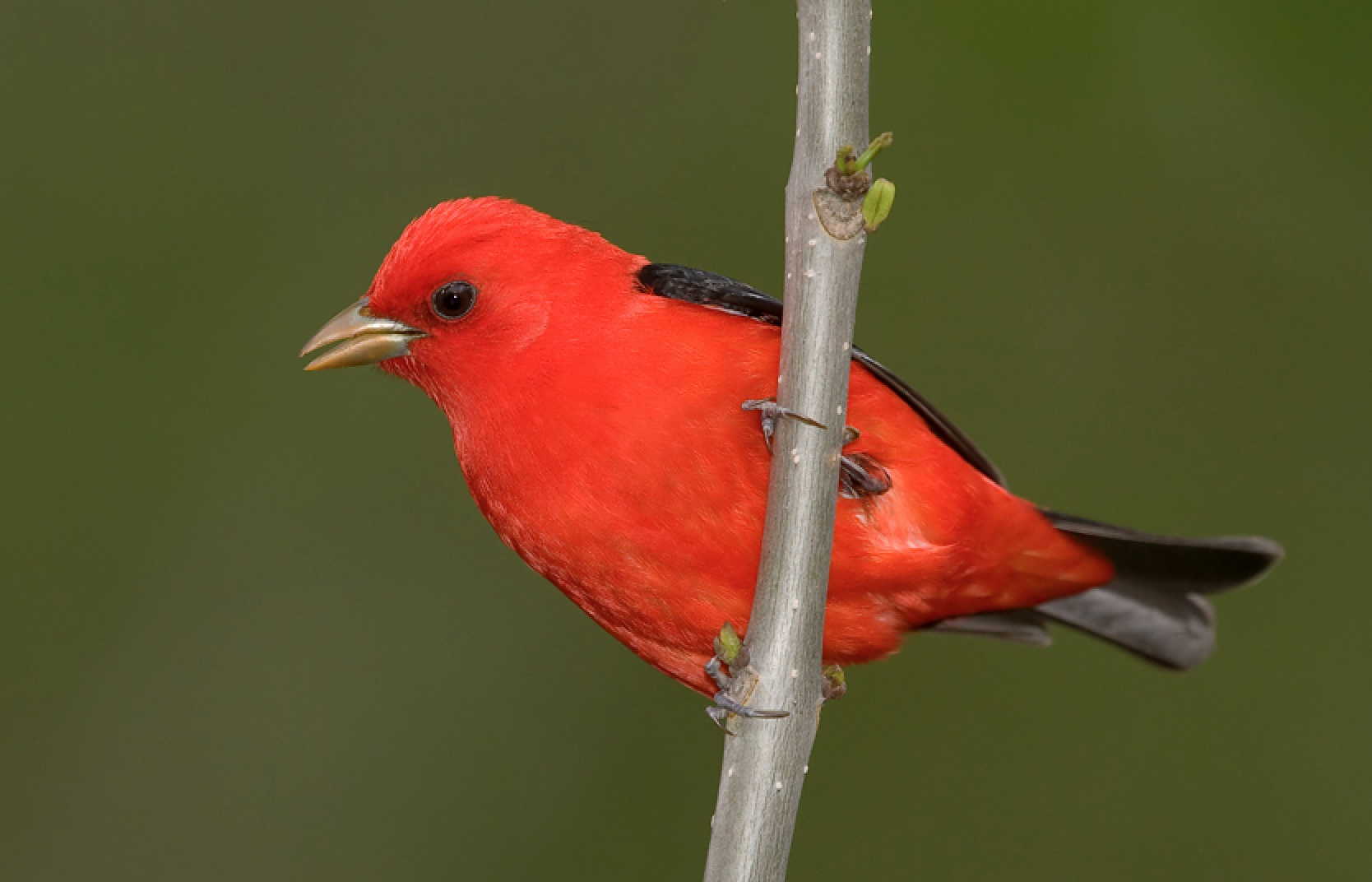 A scarlet tanager photographed at this spot in 2013.
Birding the edge of the west lawn is sometimes productive.
4. Southern
Edge of West LawnThe southern edge of the West Lawn can also be good when conditions favor the birds coming out to the forest edge. This is also a prime location to see the mourning and Connecticut warblers, and you'll often see large crowds here straining to get a glimpse of the bird back among the dense foliage inside the forest. Wading through such a mob with a large, tripod-mounted camera can be difficult, so many photographers avoid these crowds when they form. 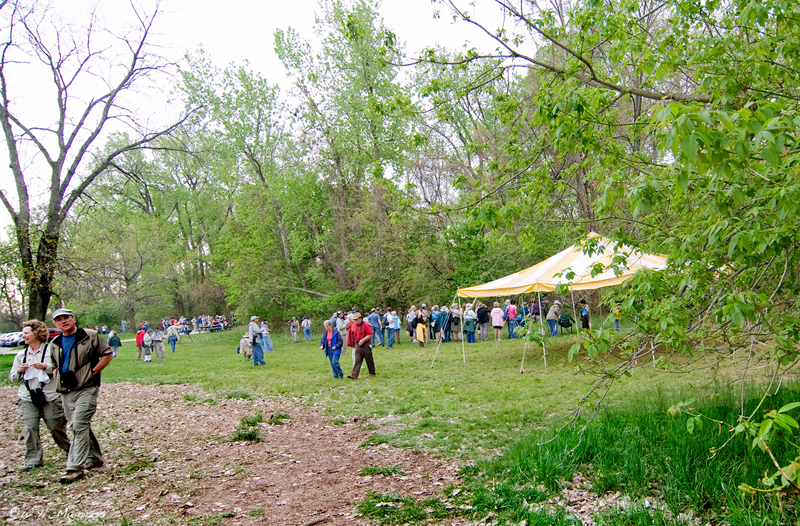 Highly desirable birds (particularly
Connecticut and mourning warblers) sometimes hang out just inside the forest edge by the west lawn, and this attracts large
crowds to the edge of the lawn (center of photo). Note the separate crowd to the left;
this is where the pedestrian road begins (or ends), and can also be productive in the right
conditions (see below).
5. Pedestrian RoadStarting at this corner and stretching eastward along the pedestrian road (which is closed to automobiles) is another section of forest edge that can be productive in the right conditions. It can also be utterly dead in the wrong conditions. When the birds are present here, they're often at eye-level (though not always).  The pedestrian road is closed to traffic and provides a lot of room, so setting up a large tripod-mounted camera rig here is feasible. (That dog is very famous, and her name is Kelsey). (Photo by Linda Huber) 6. West Entrance to Boardwalk As you enter the boardwalk at the west end, you'll see a relatively open area to your left, which the boardwalk curves around to embrace. This is often a good spot to see birds, and can be good for photography due to the openness of the area. Birds often come out of the forest, cross the semi-open area, cross over the boardwalk (where you can get excellent close-up views) and then continue out toward the parking lot (see site #20); sometimes they go in the opposite direction, but either way you can often get great views of the birds here. Unfortunately, it tends to get very crowded here because most visitors start out here at the west entrance and end up clogging up the way. 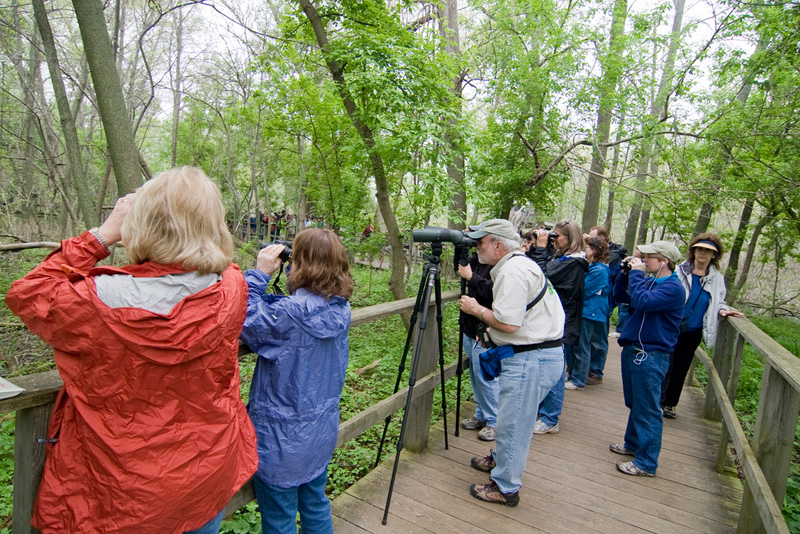 Just inside the west entrance to the
boardwalk, there's a semi-open area of forest on the left that sometimes offers some good views of warblers and other
birds. The crowd is often much more dense than what you see here.
7. Tower The area at and around the west tower can be very good for birding. The marsh is right at hand, so you have marsh habitat on one side and open forest on the other. The tower itself is a wooden structure with a platform at the top. Atop the tower you get a great view of the upper canopy, and this is often very useful in getting close-up photos of birds foraging high up.  The west tower.
The area at the bottom of the tower can often be productive
too.
Flycatchers sometimes nest under the tower steps, and prothonotaries
nest in boxes nearby. On days when there's a lot of bird activity
atop the tower, it can be very difficult to get a spot on the upper
platform, especially for photographers using a tripod (tripods are not
recommended on the boardwalk, for this reason).Left: view from below. Note how crowded it gets at the top. Right: looking down from the tower.  A Tennessee warbler foraging upside-down,
high in a tree. At the top of the tower this bird was at eye-level, permitting an exquisitely detailed view at
close range.
8. Corner Near TowerJust beyond the tower is a corner featuring a tiny resting space with a bench. There are some bushes here where you can sometimes get eye-level views of birds. Across from the little resting area is a small, semi-open area of forest where you'll often see birds foraging quite low. It's not uncommon for warblers to forage in branches hanging directly over the boardwalk, literally three feet from your face. 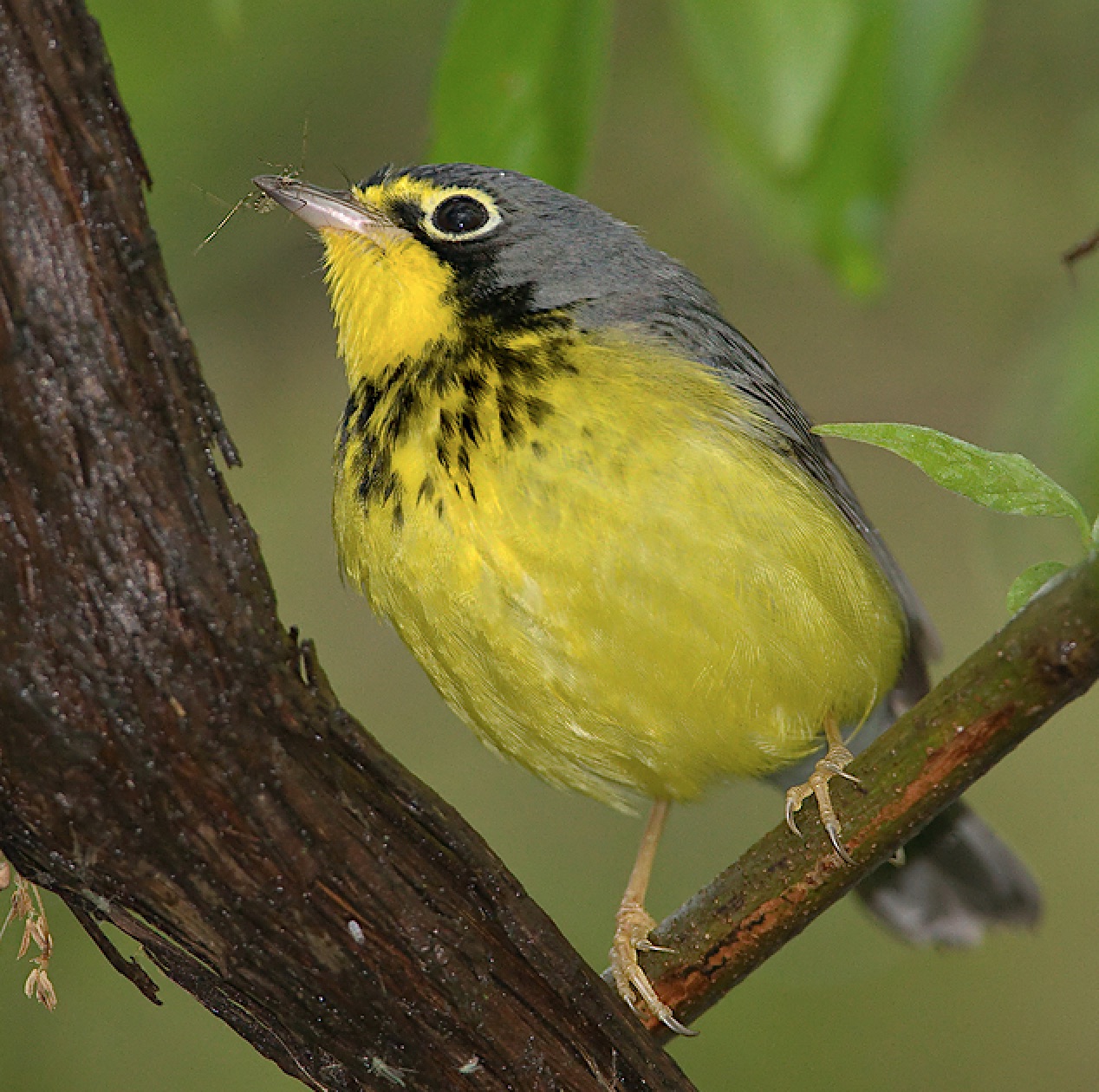 At the corner bench a little ways past
the tower, you'll often see birds foraging at extremely close range, like this Canada warbler munching on an insect.
9. Connecticut AvenueThis long stretch of boardwalk features both high trees and low shrubs. Many of the birds seen along here are high in the trees, making photography almost pointless. However, there are spots along here where Connecticut and mourning warblers are seen every year, and this is the spot on the boardwalk that becomes most congested with people when rarer species are sighted. Golden-winged warblers have also been sighted here numerous times in the past. When the crowds form, most photographers simply pass by (when it's even possible); shooting in dense crowds with a tripod-mounted rig is simply too frustrating. 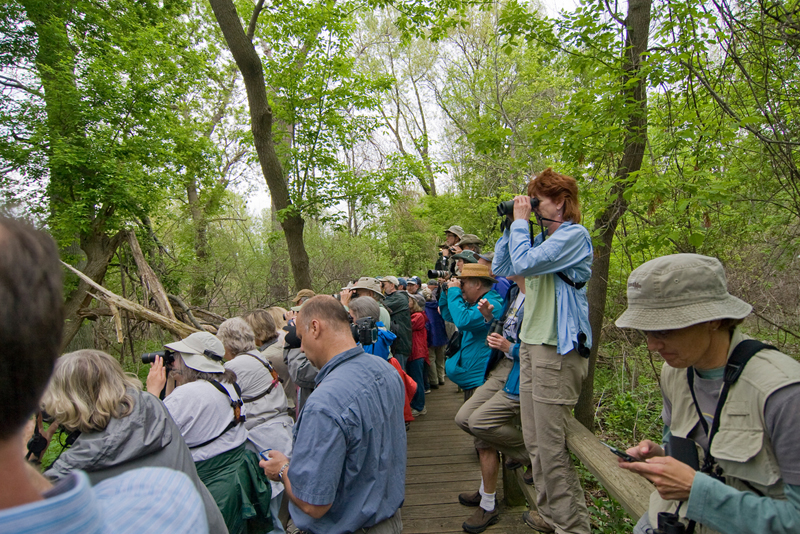 Crowds form regularly along
"Connecticut Avenue" to search for highly desirable birds such as the Connecticut, mourning, and golden-winged warblers.
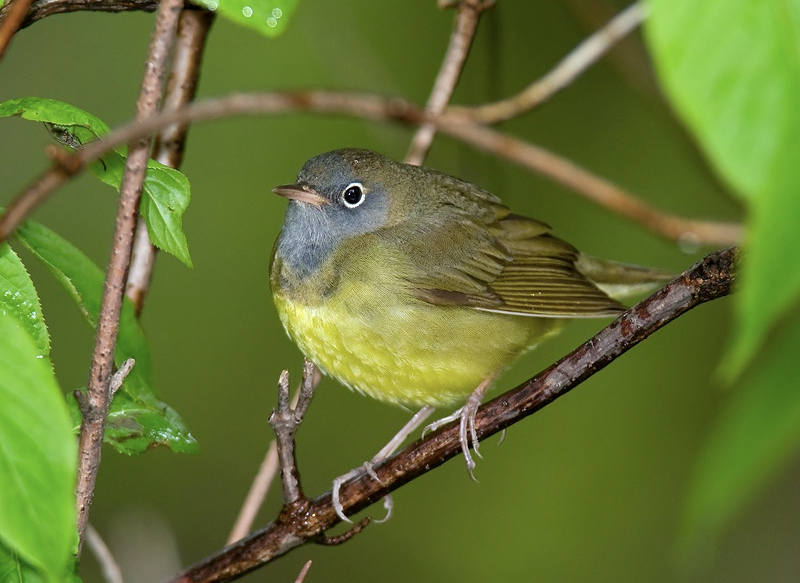 Connecticut
warblers are hard to
photograph at Magee, because they tend to stay in dense thickets where
stray branches are likely to be in the way of a clear view.
10. Small Loop This small loop of the boardwalk encloses a semi-open area of forest, and on some days the birding here can be excellent. Look for birds both within the enclosed area and all along the outer periphery, particularly to the north and east. Prothonotary warblers sometimes nest here. 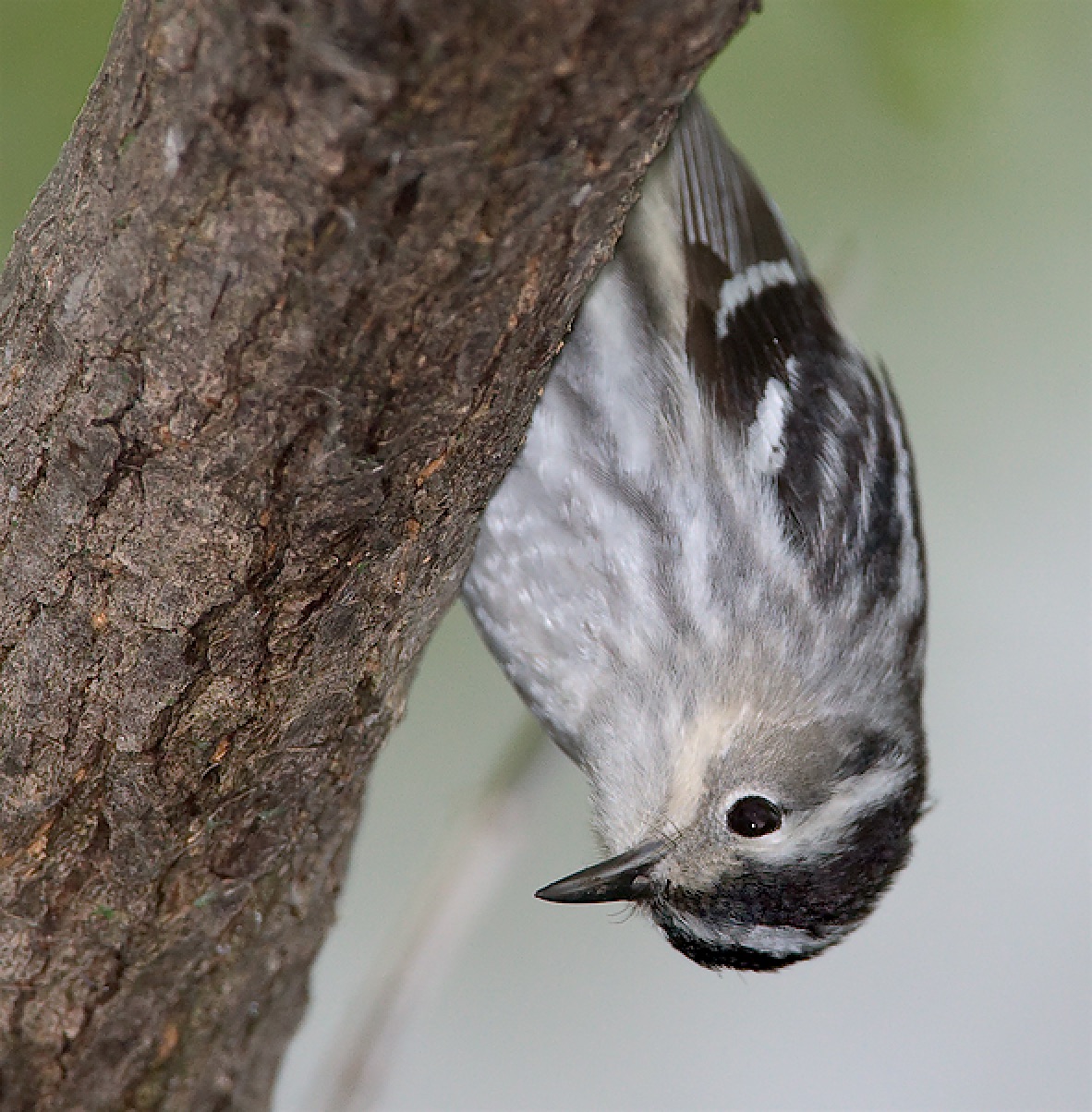 The small loop on the Magee boardwalk
can sometimes produce some good birds, and because the forest is semi-open there, it's often possible to get a relatively
unobstructed shot of the bird (like this black and white warbler hanging upside-down to to forage under this branch).
11. PierThis is a short section of boardwalk that extends out into the marsh like a "pier". The very end of the pier is typically not very productive, though the area where the pier connects to the main boardwalk can be quite good. Prothonotary warblers often nest here. Most of the activity is usually on the pier side of the boardwalk, though screech owls are sometimes sighted on the other side (and further up) and there are some nest boxes out at the edge of the pond.  The stretch of boardwalk along where
the pier juts out can produce some great birds. This immature summer tanager was a great find in
2008, and attracted an enormous crowd because it posed low in the trees mere feet from the boardwalk.
12. Northwest Corner
of Big LoopApproaching the big loop from the west, you'll cross over a small bridge, where you'll have the choice of proceeding straight or turning right. Turning right leads to an area that is often quite productive. Here at the corner the woods on the east are somewhat open, and you'll often see thrushes foraging low, and sometimes nesting prothonotary warblers. 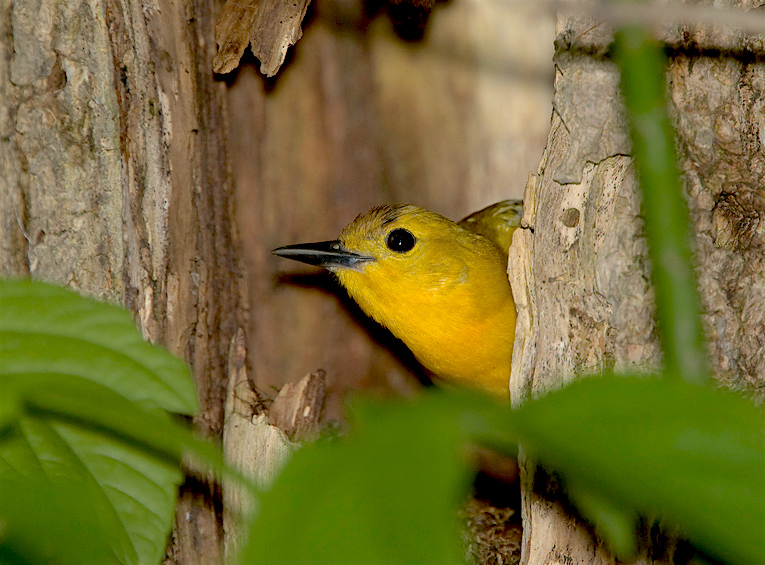 Prothonotary
warblers nest in a number
of places along the boardwalk. And they don't mind if you get
close. Nor do they mind if you use
flash. This bird eventually came out of its nest cavity and
preened on a branch mere feet from a dozen flash-wielding
photographers, without batting an eyelash. Warblers really don't
care about flash.
13. West Edge of Big LoopThis area sometimes offers the best birding at Magee. To the west is a creek and to the east is a mix of trees and open bushy areas. Warblers will sometimes forage on the ground right next to the boardwalk, literally inches from your feet, or on vines or the bark of an enormous tree. Further south toward the corner the activity often drops considerably, so there's something about this spot that the birds seem to like. 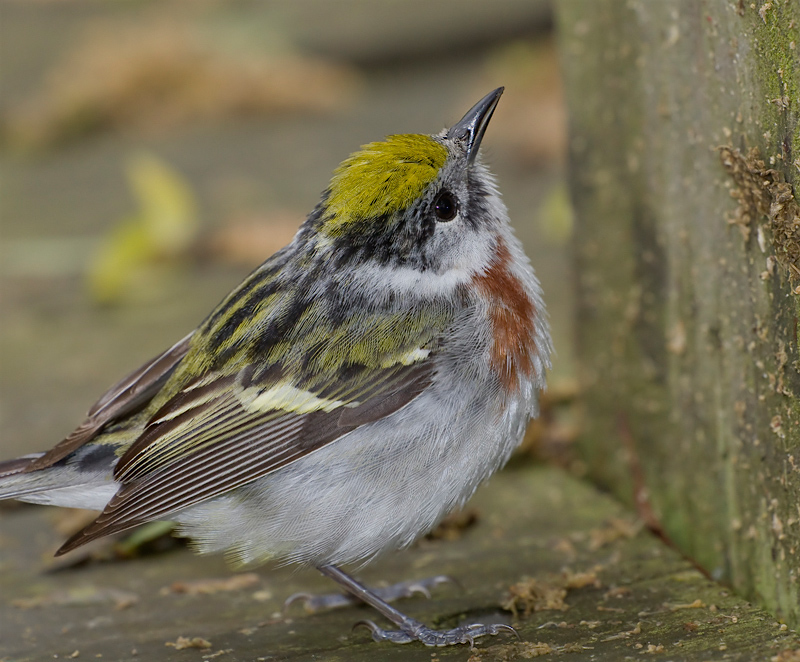 On really good days the birds will
actually walk on the boardwalk looking for tiny morsels (as this chestnut-sided warbler is doing). So please be careful not to step on any warblers!
14. South Edge of Big LoopThe entire stretch from the southwest corner of the loop to the "Big Tree Corner" some distance to the east can, one some afternoons, be very productive if you're willing to patiently stalk the birds. Photographers with a 400mm lens can do exceedingly well here on some days, as the birds often forage in bushes right next to the boardwalk at eye level. In mid-May it does get leafy here, so photographing the birds can be challenging, but an entire afternoon spent here on a good day can net a large number of "keepers". This stretch is generally better in the afternoon than in the morning. 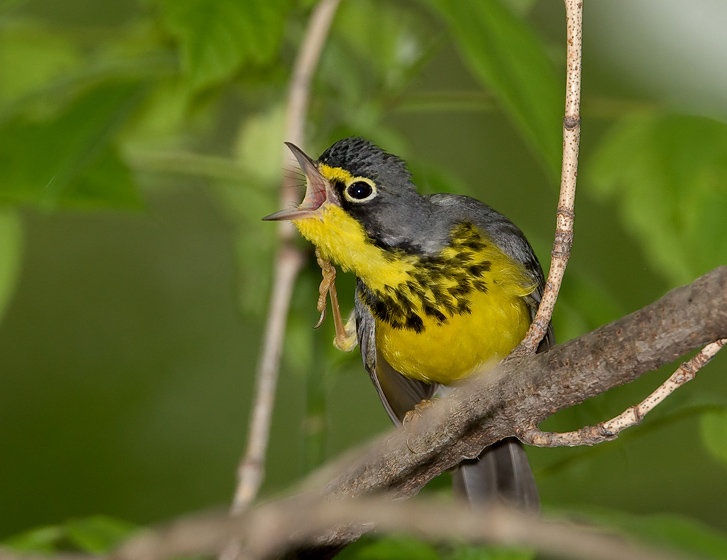 The birding can sometimes be really
great along the south edge of the big loop, though the habitat is very "sticky" and it's sometimes hard to get a clear
shot of the bird without lots of branches in the way. Afternoons are typically better than
mornings along this stretch.
15. North Edge of Big LoopThis stretch is typically the least productive part of the big loop, though the east end (at and around the corner) can sometimes produce birds. Robins and tree swallows often nest along this stretch. 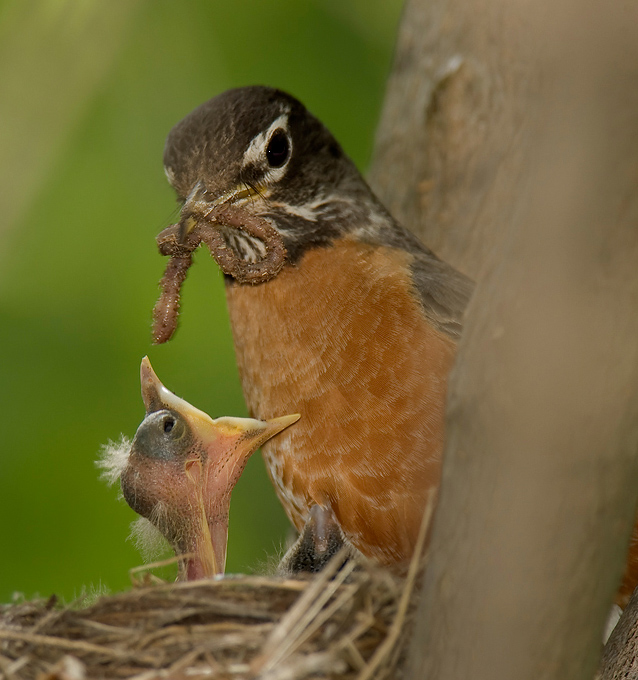 The north edge of the big loop is not
the best part of the boardwalk for seeing warblers, but there are often robin or swallow nests here (and
sometimes warblers too).
16. East Edge of Big LoopThis part of the loop can sometimes be productive, though for photography it's often frustrating because of the foliage and viny thickets. On good days you can see birds along this entire stretch. Note that this whole area of the boardwalk tends to attract fewer crowds, making photography easier.  Like
the southern edge of the big loop,
the east edge is very "sticky", so that even when you find some good
birds there (like this Wilson's warbler), you're likely to be looking
through
branches.
17. Big Tree CornerThough the map shows one corner, this is actually a tight series of little turns that go around an enormous tree bordering the marsh to the south. To the north the trees open up to reveal eye-level bushes, where you can sometimes see warblers foraging. In 2010 a yellow warbler nest was located here, mere feet from the boardwalk. 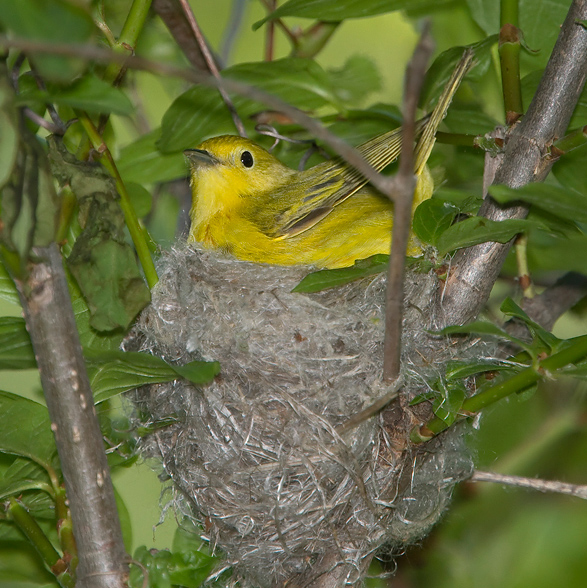 Yellow warbler nest at the Big Tree
Corner in 2010.
18. East StretchThough the easternmost stretch of the boardwalk is sometimes productive, the main attraction here is the lack of crowds. Whereas the west end of the boardwalk often gets so crowded that you literally can't get through, here at the east end you have room to move around, so that you can stalk the birds. To the north is woodland, while to the south is a marshy channel bordered by bushes and in some areas a thin line of trees. Herons and egrets are sometimes seen in the channel, and three or more species of swallows (tree, barn, bank) are often seen hawking for insects. 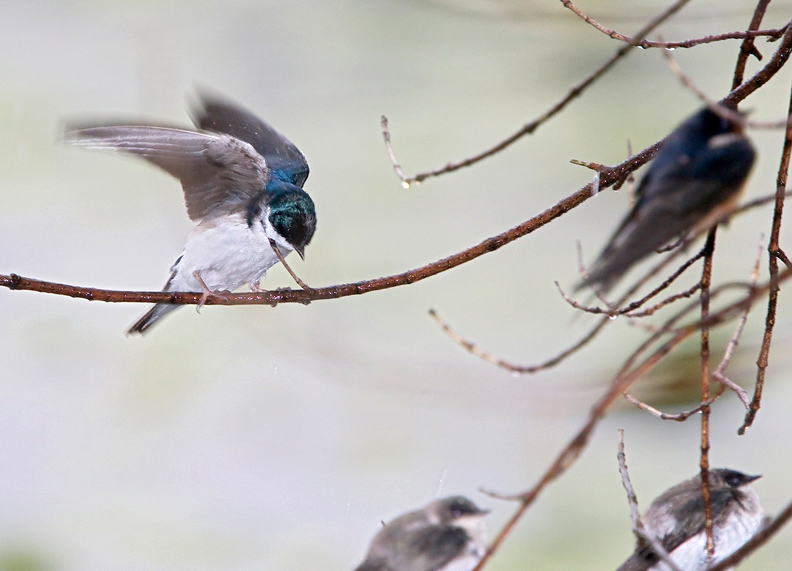 The best thing about the easternmost
stretch of the boardwalk is that there are usually very few people there. And sometimes there are birds.
19.
East Entrance to
BoardwalkOn good days you can see some warblers here at the east entrance, including a small stretch along the road and just inside the boardwalk. Out on the road you can walk east and see the edge of the open marsh, where blackbirds and swallows are often found among the reeds. 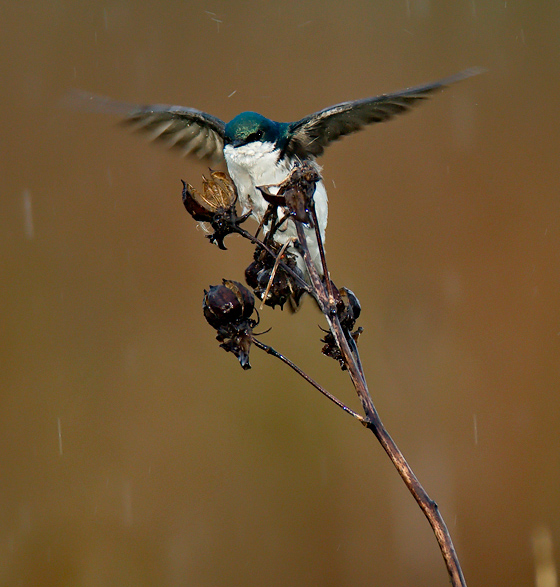 A swallow in the marsh on a rainy day,
close to the east entrance of the boardwalk. You can still see birds on rainy days at Magee!
20. Scrub LineAlong the southwest edge of the westernmost parking lot is a line of scrub bordering the marsh, where you can sometimes get lucky and catch one of the rarer warblers such as Connecticut, mourning, or orange-crowned. Most of the time, though, this area is dead. The restrooms are located here. Some birders park their cars here and eat lunch at their cars, keeping an eye on the scrub for any warblers emerging from the marsh. 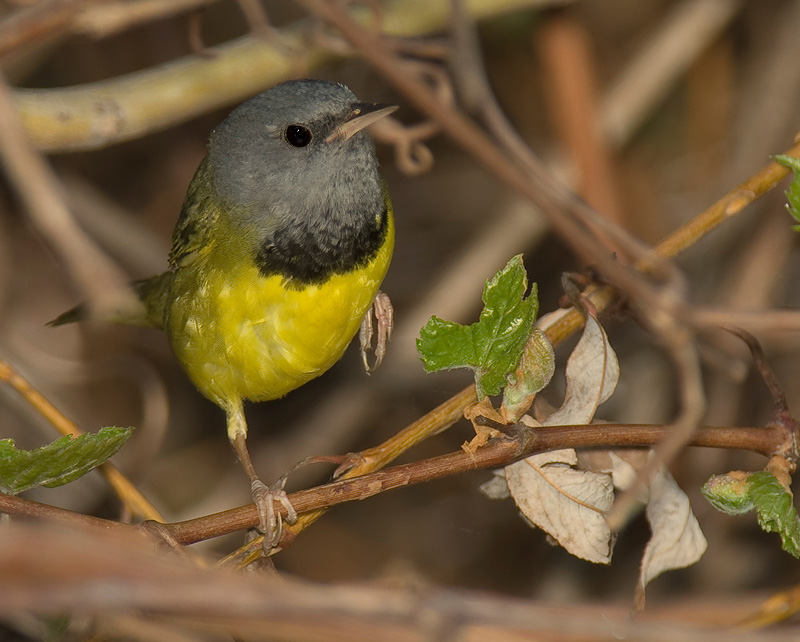 The southwest edge of the parking lot
is often dead, but occasionally you'll get lucky and see a great bird sneak out through the brushy vegetation bordering the
marsh (like this very secretive mourning warbler).
21.
West Edge of Parking
LotLike the southwest edge of the lot, this western edge features some scrub habitat where birds are occasionally seen. 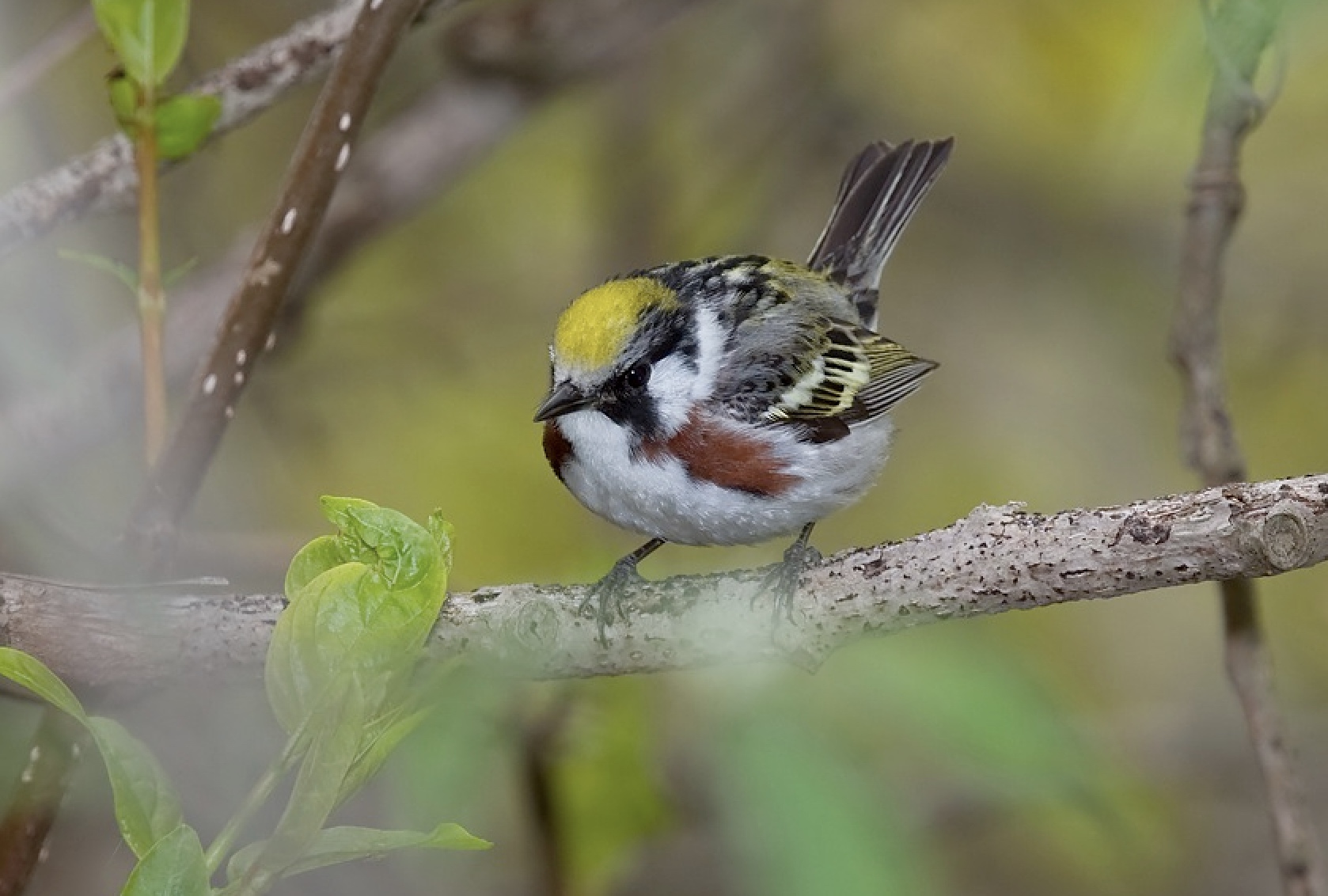 The
west end of the parking lot isn't a
great place to find birds, but sometimes you do see them there, like
this chestnut-sided warbler. And there's rarely a crowd here to
contend
with.
22. West End of BeachJust past the parking area, out on the beach, public access is forbidden due to nesting birds. There is a short trail just inside the woods here where you may see some birds. Visitors with dogs often let them swim here at lunchtime. 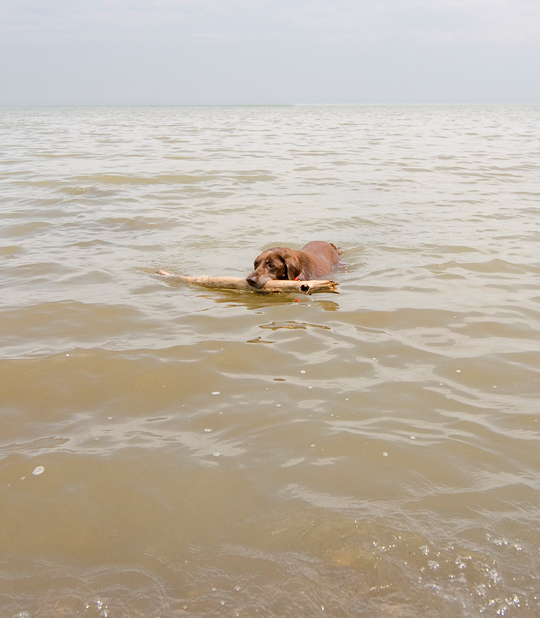 Visitors with dogs often let them swim
in the lake during their lunch break. Note that dogs are allowed in the park, but not on the boardwalk or the trails.
23. East End of Beach Most years at Magee a Kirtland's warbler is reported, and very often it's out on the beach to the east of the boardwalk area. Public access is permitted here, and you can walk quite far along the beach. Though not prime birding (compared to the boardwalk), birders often come out here to try their luck at finding a Kirtland's that has strayed from its normal migration path up into Michigan. 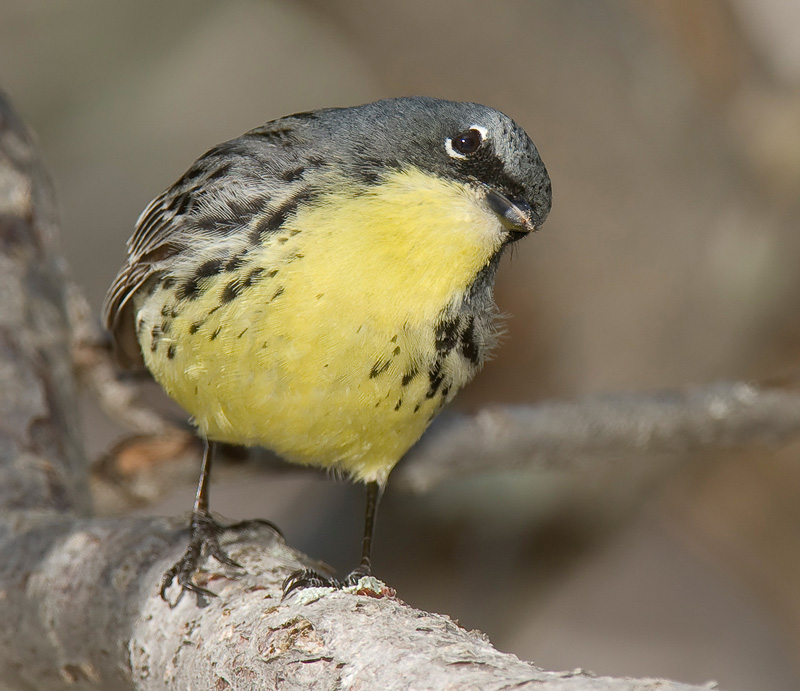 Kirtland's warbler seen by thousands of viewers along the east beach at Magee in 2010. Other Spots at MageeThough the boardwalk typically offers the very best birding at Magee, there are a few other spots that you may want to try. Leaving the boardwalk area by car, the first area you'll come to is the open marsh, where there are several gravel pull-offs that will accommodate two or three cars. Out here you can see herons and egrets, ducks, many geese with goslings (in May), and sometimes bald eagles actively hunting. Further along the road toward the park's exit you'll come to the sportsman's center, which has a loop trail that sometimes produces birds. Beyond that, on the final stretch toward the exit you'll very often encounter yellow warblers in the bushes that line the road. Finally, if you go out to route 2 and head west you'll come to Ottowa NWR, which is directly next to Magee Marsh.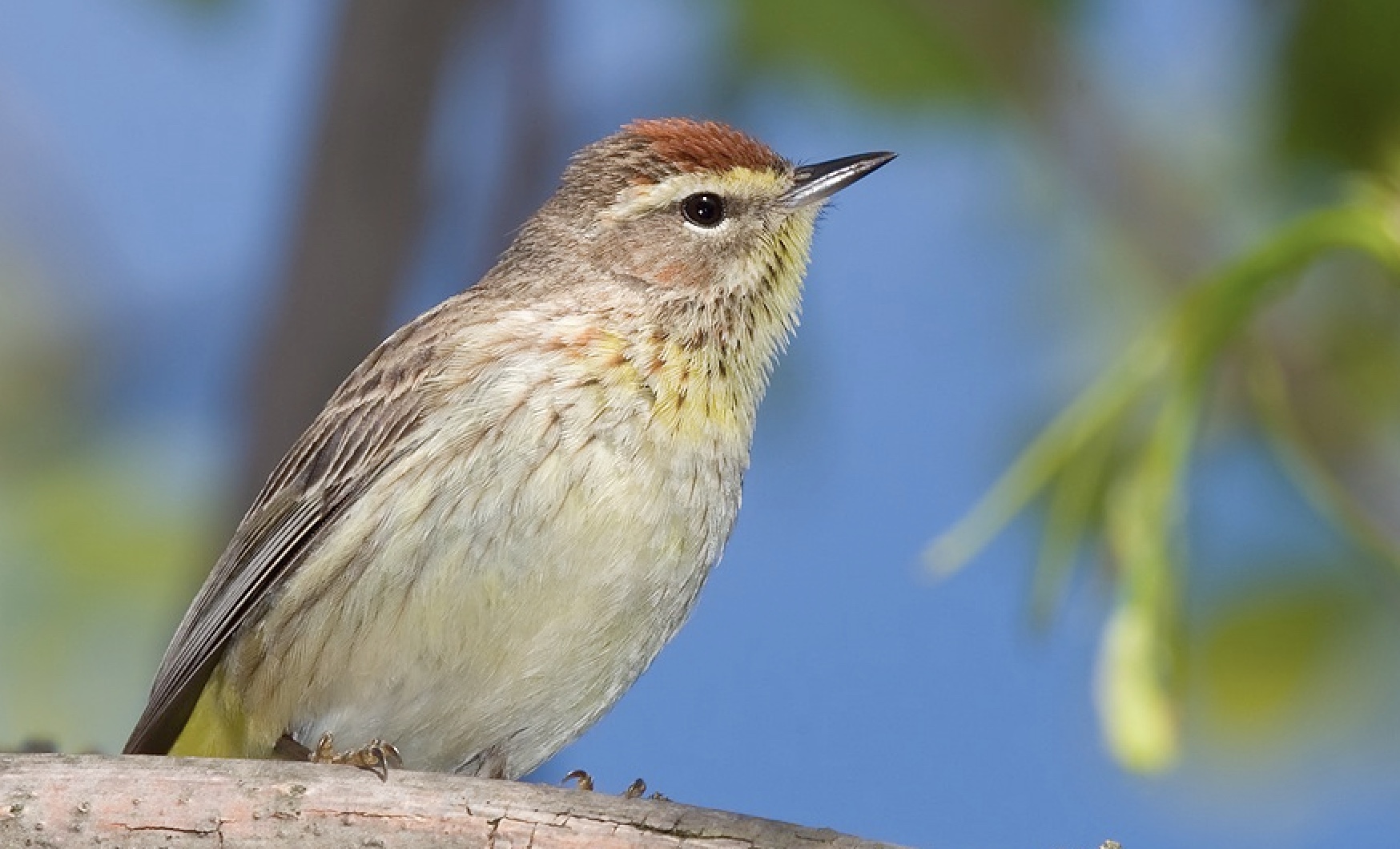 A palm warbler photographed behind the sportsman's center at Magee. 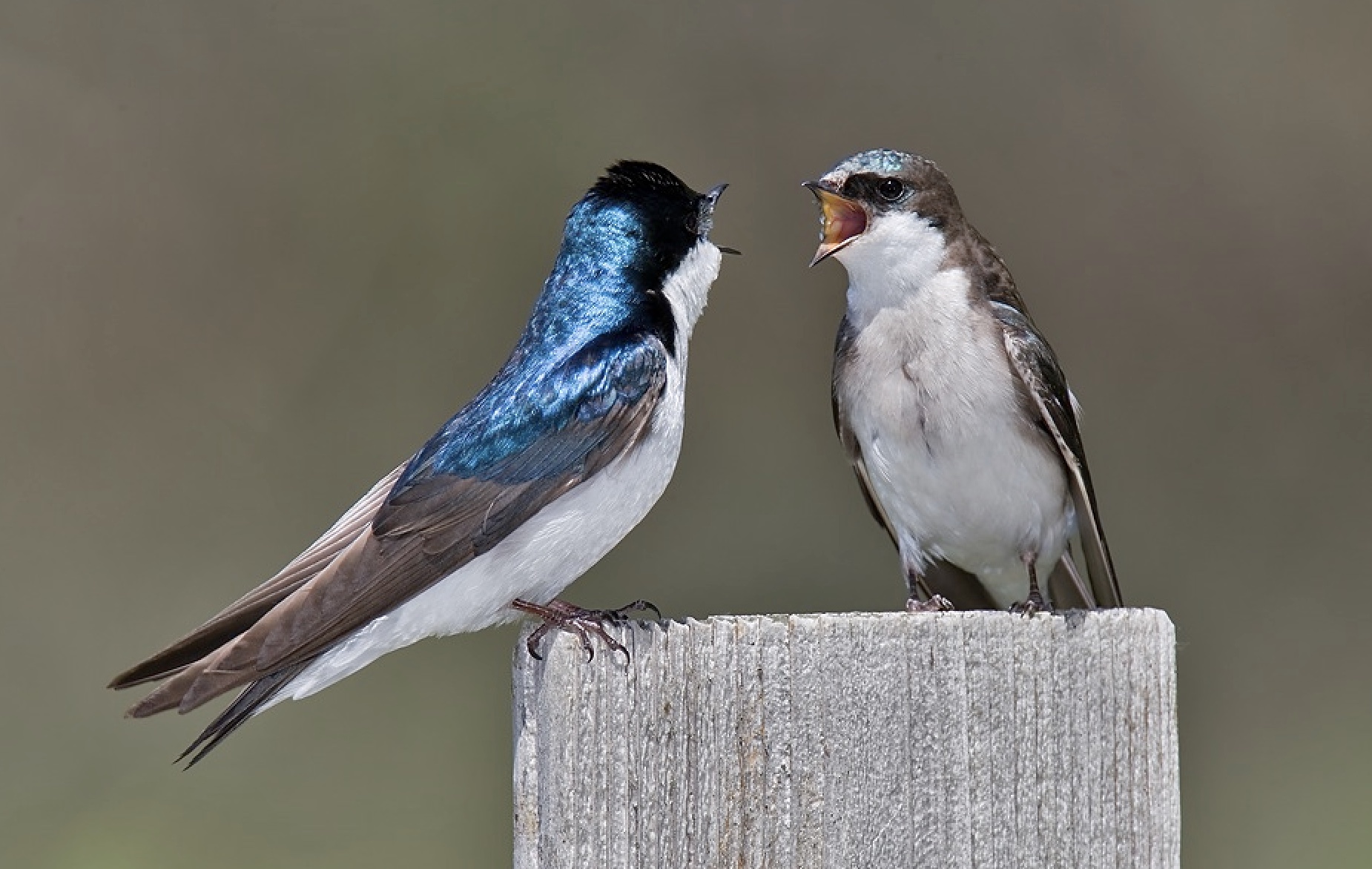 Swallows arguing behind the sportsman's center at Magee. Magee isn't only about warblers! Identifying BirdsThough it's by no means necessary to identify every bird that you see in order to enjoy the experience of seeing them and watching their behavior, most people like to know what type of bird they're looking at. The Field Guide section of this web site provides a very crude introduction to warbler identification, though you'll likely want to buy a real, print guide such as the ones by Kaufman, Sibley, Peterson, Audubon, etc. During peak migration season you'll often be surrounded by many other birders, many of whom are experts at identifying birds. Don't be afraid to ask for help from other birders in identifying any bird you see; if it's a bird they haven't caught sight of yet, they'll typically be grateful for having the bird's presence pointed out, and won't mind ID'ing the bird for you.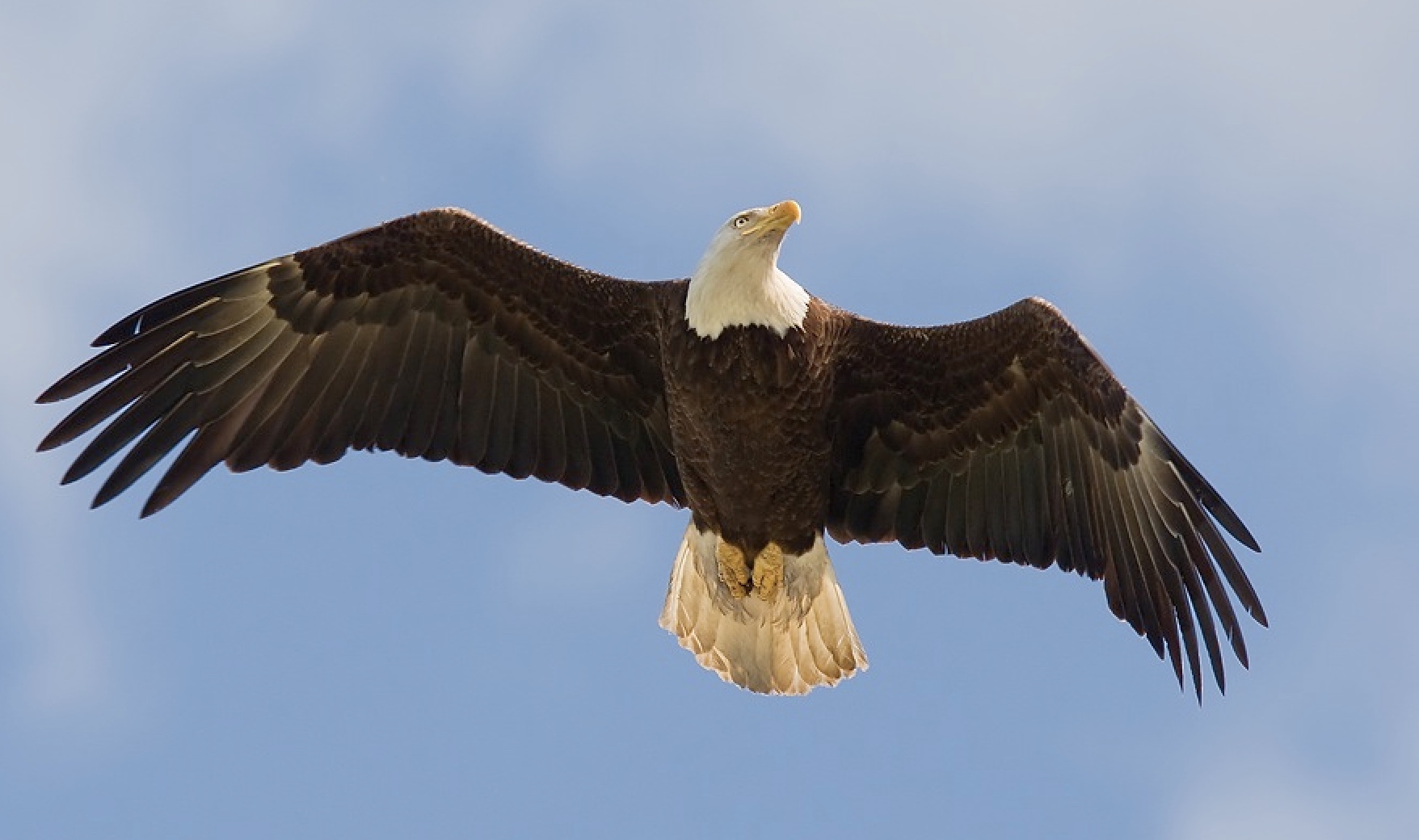 Bald eagles sometimes show up at Magee, and generally aren't difficult to identify. But other birds can be harder to ID, so don't be afraid to ask other birders for help! Binoculars and Spotting ScopesWarbler watching at Magee is typically best done with a good pair of 8x32 or 8x40 binoculars. Though 10x binoculars will give you more magnification and therefore more detail, 10x binoculars typically have a restricted field of view that makes it harder to follow fast-moving birds at close range (i.e., you'll tend to often "lose the bird" as it moves around). 8x32's typically have nice, wide fields of view, and are very lightweight. The very best binoculars are those made by Swarovski and Leica, though other companies such as Nikon and Zeiss have offerings that in some cases are essentially as good in most respects. Unfortunately, these are typically $1000 (US) or more. Quality optics at more affordable prices can often be obtained from companies such as Eagle Optics. Be sure when picking a pair of binoculars to check the minimum focus distance (MFD); sometimes the birds at Magee get so close that binoculars with a large MFD can't focus on the bird. It's also advisable to choose a pair that are waterproof, so that you don't have to stay at home (or in the hotel) on rainy days.Spotting scopes tend to be rare on the boardwalk at Magee. They require a tripod, which is extremely inconvenient on the boardwalk, and they can be easily knocked over by passers-by. Though the birds are sometimes high in the trees (where a spotting scope can be handy), on good days they're at eye-level and you really don't need the scope. The Use of Recorded Bird CallsThe use of recorded bird calls, such as via an iPod or other portable device, is not recommended at Magee, especially on the boardwalk, and doing so will earn you a strong rebuke from hordes of annoyed birders. Though the use of such techniques may be justified at other sites, the presence of large numbers of people in a small place makes the use of recorded calls an annoyance for both other birders and for the birds.ChecklistsMany birders like to keep a "checklist", so they can remember which birds they've seen. One good thing about keeping a checklist is that you can enter your sightings into eBird, the online database of bird sightings. The eBird database is useful to conservationists and scientists studying migration and population trends, so we highly recommend that you enter your checklists into eBird.Click here for the Magee Marsh Boardwalk Checklist Click here for the eBird checklist for Ohio. Click here for the USGS checklist for Magee Marsh . Time of DayBirding on the Magee boardwalk can be productive at all times of the day. Though many birders are used to doing their birding in the morning, sometimes the afternoon is just as good or even better (depending on conditions). Note also that rainy days can be very productive as well, with the added bonus that the crowds tend to be much thinner. Just wear a raincoat with a hood, and make sure your binoculars are waterproof.Basic NecessitiesRestrooms are available in the parking lots, but keep in mind that when you're in the middle of the boardwalk surrounded by hundreds of other birders, getting to the nearest restroom can take quite a bit of time. The boardwalk is wheelchair accessible, and there are handicap parking spaces. There are no water fountains nor vending machines near the boardwalk, though there are picnic tables in the west lawn where you can eat a packed lunch. Much of the boardwalk is shady, so sunscreen is often not critical, and in May the presence of mosquitos and other pests typically doesn't require insect repellent.Photographing BirdsPhotographing warblers at Magee Marsh can be fun and productive, though it can also be very, very challenging. Though you'll see quite a number of pro photographers with big 500mm and 600mm lenses at Magee, the most popular and practical solution for bird photography along the boardwalk is a high-quality 400mm hand-holdable lens. A 400mm f/5.6 lens with a short MFD (minimum focus distance) can be ideal on days when the birds are foraging at eye level. Note that you can use an extension tube to decrease the MFD if necessary. Many birders use a rig consisting of a 400mm f/5.6 lens (zoom or non-zoom) attached to a DSLR camera and an external flash unit. On our Photography Tips page you'll find lots and lots of information about techniques for photographing warblers.Other Sources of InformationWhen birding at Magee, the most common source of information is from other birders. Most birders will happily aid you in identifying a bird, and there are often professional tour guides present on the boardwalk during the festival who will gladly use a laser pointer to help you find an elusive bird that is present but hard to see.If you have a handheld web device such as an iPhone or Blackberry, there are several web sites that might be useful for keeping up on current conditions and recent sightings: |
||||||||
|